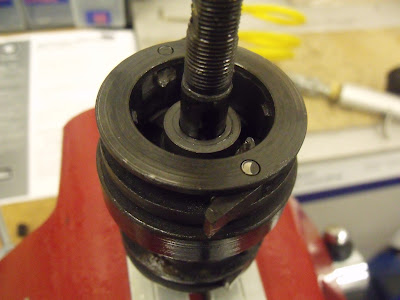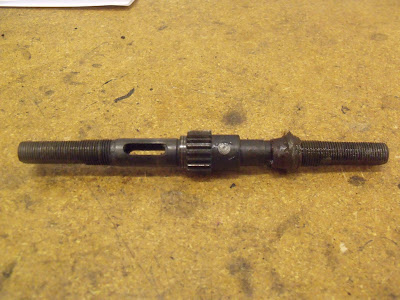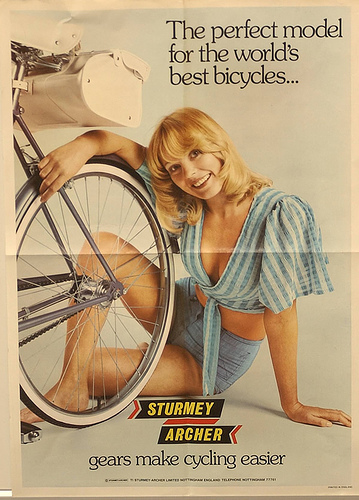Barring a brief but powerful burst of inspiration the
other night, two of my
previous posts have been about my overhaul of a Sturmey-Archer AW three-speed hub. This final entry on the reassembly will mostly contain my attempt at explaining how they work, and a little bit of my experience actually rebuilding it. I won't go into great detail on that, because it is simply the process of taking it apart, this time in reverse.
 |
All of the parts of the hub, completely disassembled and laid out. Fifty-seven parts total,
counting groups of ball bearings that go together as a single "part".
Taken on July 13, 2013 |
As I did before, I'll start by saying I didn't figure out exactly how the hub worked on my own. I was completely stumped. The same goes for my coworker. After we had rebuilt the inner assembly a few times, we admitted to eachother we weren't sure how the the shift actually changed gears on the inside. We discussed it for a short while, even with a third coworker who was nearby, but could still not really figure it out. I decided I probably couldn't figure it out on my own, so I went to where all great men find answers: Youtube. It didn't take long for me to find a video that explained the actual mechanics of it.
This video is what I watched to understand the hub. It's a little long and sort of takes a while to get to what I consider the "good stuff", but if I fail to explain it well here or you're just curious, definitely check it out. The guy does a good job of explaining it.
Before you can really understand how almost any internally geared hub works, you need to understand the concept of planetary gearing. In order to understand that, you need to understand the concept of just ordinary gearing. It was something my dad explained to me when I was a kid, one of those wonderful little moments I can hardly remember but has stuck with me throughout the years nonetheless. I'll try to explain it in a way similar to how he explained it to me.
 |
A set of gears, one obviously larger than the other. If the larger gear were to turn,
the smaller gear would turn more quickly than the larger gear.
Source |
The principle of gearing is that if you have a small gear mesh with a larger gear, and you turn one of them, it will affect the speed of the other. If you turn the small gear, the large gear will turn more slowly than the small gear. If you turn the large gear, the small gear will turn more quickly than the large gear. This happens because when you turn, for example, the large gear, you're forcing the small gear to travel the the same amount of distance in the same amount of time. A great way to think of it in this situation is that you're making the small gear "catch up." Inversely, if you're turning the small gear, you're forcing the large gear to "hold up." It's a mechanical principle that is very important to understand, but is most easily understood when experienced. Hopefully this explanation works for now.
 |
The sun gear (yellow arrow), ring gear (black arrow), and planet gears (white arrow) of a
Sturmey-Archer AW hub. This is where the transfer of power usually takes place.
Taken on July 17, 2013 |
To graduate to understanding planetary gearing, you have to switch things around a little and add a third component. This third component could be a few different things, depending on how exactly the planetary gears are setup, so I'll define it by the one quality it always has: it is fixed, and does not move. I'll only talk about the configuration used by internally geared bicycle hubs; there are a few other, rather different ways that a planetary geared system can be set up, and this really isn't the time or place to get into it.
For an internally geared bicycle hub, you're going to have three main components: the sun gear, the ring gear, and the planet cage, which houses the planet gears. The sun gear is the fixed component, as mentioned above, and is always fixed. Being part of the axle, it is affixed to the frame, and everything else in the hub revolves around it. Now, this is where it can get a little confusing. Think of the ring gear as our small gear, from the example above. Yes, the ring gear, which is the biggest component in my picture! Now, think of all the planet gears, which are assembled together in the planet cage, as the large gear. But the planet gears are so small! Yes, you're right. There is some math that backs up this seemingly backwards concept, but I am not a math-oriented mechanic, and I'm not an engineer. You can find the equations on the Wikipedia article for
epicyclic gearing, if you are that kind of mechanic. But for now, I'm just going to explain it in that way because I feel it allows the overall mechanics of the hub to make sense.
So, whenever you turn the ring gear you're making the planet cage turn more slowly. We'll call this under drive. Whenever you turn the planet cage, you're making the ring gear turn more quickly. This we'll call over drive.
Understand? Good, I hope so.
No? Sorry! Maybe try the video I linked to above, he does a pretty good job of explaining planetary gearing.
From now on, it can get a little more confusing because I'll be talking about two very different things that are both called gears: the actual physical gear inside the hub, and the configuration of gearing to give you, the user, different gear configurations. To differentiate, I'll refer to the physical gears as whatever their name is, for example the "ring gear", and to the gear configurations as "transmission gears."
Also, I made a series of color coded diagrams in MS Paint to literally illustrate what I may not be able to illustrate with words. For each transmission gear, I've provided a diagram with color coded parts, and another diagram showing the power flow, labeled with colors. They are not completely accurate illustrations, but the proportions work well enough and more than anything it gets my point across. I hope they help.
Now, onto my hub. The AW hub has three transmission gears, which can be labeled as such: an over drive transmission gear, a direct drive transmission gear, and an under drive transmission gear. For each of these transmission gears, the clutch is pulled to a different position along the axle by the cable attached to the shifter on the handlebars. Remember how the clutch slides along the axle? In all of these positions, the clutch is also doing a very important job: it is transmitting the power of the driver, which is attached to the sprocket, which is powered by pedaling, to a different part in the hub.
 |
Left: Clutch in the over drive transmission gear position.
Right: Clutch in the under drive transmission gear position.
The direct drive transmission gear position is somewhere inbetween.
Taken on July 13, 2013 |
 |
The driver. Note the notches, which the clutch slides along. The clutch is always
within these notches, transmitting power to the rest of the hub.
Taken on July 11, 2013 |
In the under drive transmission gear, or the "first gear", the clutch is pulled out as far as it can go. When it is in this position, it is disengaging the pawls found on the ring gear. These pawls can be thought of as little spring-loaded teeth; they engage when they're turned in one direction, and disengage when turned in the opposite. They are crucial to how just about anything with a ratchet works, and are found on any bicycle that isn't a fixed gear bicycle. In the under drive transmission gear of my hub, however, the clutch is actually disengaging the ring gear pawls and transmitting the power of the driver to the ring gear via the raised "dogs" on the inside. I noted these in the
previous Sturmey-Archer post, but I'll point them out again.
 |
Left: The ring gear, with the pawls visible.
Right: The ring gear on the assembly, for frame of reference.
Taken on July 13, 2013 |
 |
The raised "dogs" (white arrow) on the inside of the ring gear. While in "first gear", the clutch
pushes in the pawls (black arrow), disengaging them, and transmits power to the dogs.
Taken on July 11, 2013 |
 |
Left: Bottom set of pawls visible. These are the planet cage pawls, which engage with the hub shell.
Right: The ratcheting surfaces on the inside of the hub shell, which engages with the planet cage pawls.
Taken on July 11, 2013 |
So in the under drive transmission gear, we have power being transmitted to the gear ring. This means that the planet cage and planet gears are turning more slowly than the gear ring. Remember? The planet cage has its own set of pawls, which drive the hub shell itself. They only engage the hub shell in this under drive transmission gear, or "first gear". In the other gears, the hub shell is actually spinning too quickly for the pawls to engage.
 |
Under drive transmission gear diagram. Note the position of the Green clutch, disengaging
the Blue ring gear pawls, and mating with the raised "dogs".
Created on August 5, 2013 |
 |
Power flow diagram for the under drive transmission gear. It starts with the sprocket
and driver, goes to the ring gear, turns into under drive at the planet cage, and is transmitted to the hub.
Created on August 5, 2013 |
That's the under drive transmission gear, or "first gear." The direct drive transmission gear, or "second gear" is a little interesting, namely because it completely ignores the whole planetary gear assembly! In this transmission gear, the clutch is somewhere in the middle of its movement range. I say somewhere because I don't believe it's terribly crucial where it goes. One thing is important though, and that is the clutch moves inward enough to allow the gear ring pawls to begin to engage. Remember how in the under drive transmission gear the clutch pushes in and disengages the gear ring pawls? Well, in the direct drive transmission gear, those pawls are now engaged. These pawls interface with the ratcheting surfaces of the ball ring, which is threaded directly into the hub shell.
 |
Left: The gear ring pawls.
Right: The ratcheting surfaces of the ball ring, which interface the gear ring pawls. The
ball ring itself threads directly into the hub shell.
Taken on July 11, 2013 |
This means that we have a one-to-one ratio; for every full rotation of the sprocket and driver, the entire hub also makes a full rotation. The hub shell is spinning so quickly at this point that the planet cage pawls can't catch up! The entire rest of the planetary gear assembly is being ignored at this point; mechanically speaking you're riding a single speed bicycle.
 |
Diagram of the direct drive transmission gear clutch position. Note the engaged ring gear pawls.
Created on August 5, 2013 |
 |
Power flow diagram for the direct drive transmission gear. We start at the driver, which
transmits power to the ring gear, which puts it right back into the ball ring and the
rest of the hub. The planetary gears are essentially doing nothing.
Created on August 5, 2013 |
Finally, we have the over drive transmission gear, or "third gear". For this transmission gear, the clutch is in its natural position, with the clutch spring pressing it inward as far as possible. In this position, the clutch is no longer interfacing with the ring gear at all; now it is interfacing directly with the planet cage. Each of the four pins which hold the planet gears in the planet cage are actually long enough to protrude from the top of the planet cage. This is so that the cross-shaped clutch can interface with them, and transmit the power to the planet cage directly.
 |
The clutch, resting on the planet cage. This is exactly how it would appear in the over drive
transmission gear. Note how the clutch can contact each of the four pinion pins, transmitting power
to the planet cage directly.
Taken on July 13, 2013 |
So while in the over drive transmission gear, power is being transmitted to the planet cage. This means the gear ring will turn more quickly. The pawls on the gear ring interface with the ball ring, and the hub shell turns more quickly. The pawls on the planet cage can't catch up with the hub shell, and you are zipping down the road in your over drive transmission gear, or "third gear".
 |
Over drive transmission gear diagram. The Green clutch is driving the Red planet cage.
Created on August 5, 2013 |
 |
Power flow diagram for the over drive transmission gear. The driver transmits power to
the planet cage, which then turns it into over drive and carries it to the ring gear, which mates
with the ball ring and drives the hub.
Created on August 5, 2013 |
That's it. I've now explained how a Sturmey-Archer AW three-speed hub works. Phew! The video I watched to learn how these hubs work goes into some detail on the actual ratios, and also provides a good visualization of how everything works when the inner assembly is together and functioning. That's something I just can't convey in text or still pictures, so I would recommend watching it. I've linked to where that starts in the video
here.
 |
Diagram for the "false neutral" clutch position. Note the Green clutch is not engaging
any other part of the hub.
Created on August 5, 2013 |
 |
Power flow diagram for the "false neutral" transmission gear. The power comes in through
the driver and clutch, and then goes nowhere. Your pedaling will get you nowhere.
Created on August 5, 2013 |
There is an infamous design flaw in this hub, however, which could possibly give the user a "false neutral" transmission gear, that is, a transmission gear where there is no drive. This is a sign of the cable not being properly adjusted. Inbetween the over drive and direct drive transmission gears, there is a sweet spot where the clutch won't interface with anything. When this happens, you can pedal all you want, but you won't go anywhere. Usually, increasing cable tension should fix this, although that is a generalized fix and anyone's situation could be different. After Sturmey-Archer was acquired by
SunRace in 2000, SunRace sought to fix this design flaw and they seem to have succeeded. Essentially, the principle of how the hub works is exactly the same in the newer NIG (No Inbetween Gear) hubs, with the only difference being a totally redesigned clutch and driver. I won't go into any details on it, but you can watch a video explaining the differences by the same guy I referenced earlier. His video can be found
here.
 |
The milled surface of the axle, with the lockwasher visible. Note the two bent edges,
which restrict the cone to quarter-turn positions.
Taken on July 13, 2013 |
Putting everything back together went pretty well. I used a vise-grip as an improvised vise so that I could keep my axle vertical as I photographed and slid everything together. There is a bit of a trick to adjusting the bearings. The axle is milled to have two flat planes on each side, so that the axle doesn't accidentally spin while in the frame. This is actually crucial to how the whole thing works in the first place. Remember how the sun gear is fixed, and has to stay fixed? In addition to that, the milled axle also works with a special lockwasher that fits over the drive-side cone. Because of the way this lockwasher is shaped, the drive-side cone can only be at quarter-turn positions. When setting the adjustment, you are supposed to find the position that would feel right for a normal hub, and then actually loosen the cone a quarter turn or two so that it fits into the lockwasher. Then, on the non-drive-side cone, you adjust the bearings like normal. You do this because of that third bearing group, in the ball ring, so that everything is able to spin freely. You actually want a very small amount of play in the bearings for this reason.
The hub is sitting on my little work table now. The next step is to obviously lace it to a rim, but I am still trying to figure out what I want to do for that. When I get to that part, another post will come, but for now I think I can feel satisfied with my three-part series on three-speed Sturmey-Archer hubs. Enjoy.
 |
Top: Everything together after the final rebuild. So shiny.
Taken on July 13, 2013
Bottom: Dirty, grimy before shots.
Taken on July 10, 2013 |
Writing this post was actually rather difficult, and proved to be the greatest challenge I've experienced with this blog yet. To be honest it forced me to refine and indeed correct my understanding of how the hub worked. I think I've finally realized why they have us write papers in school, as it is apparently supposed to force us to make sure we completely understand what we're writing about. Unfortunately, I didn't have that mindset in school. Thankfully, I actually care now.
















































